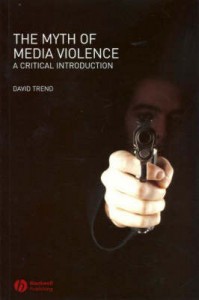 The Myth of Media Violence: A Critical Introduction, Blackwell Publishers (2007).
The Myth of Media Violence: A Critical Introduction, Blackwell Publishers (2007).
The Myth of Violence seeks to extend the conversation about media violence beyond simple arguments of condemnation or support. In questioning typical views of media violence, we’ll view the topic in a broader context––taking into account the social, economic, and political factors that encourage and thrive upon violent entertainment. Also addressed will be the uses that violent stories play in education, art, and historical accounts of violent occurrences in human history resulting from war, genocide, and natural catastrophe. In addition, the book examines the distinctly American style of much media violence. Historically the United States dominated global media production and was the source of most of the movies and television the world saw. The picture changed somewhat when multinational corporations began restructuring production and distribution in the 1980s and 1990s, but the influence of American-style TV and movie making has endured even in the face of burgeoning media industries in India, China, Japan, and Europe.
Beginning with a look at history, this book chronicles concerns about violence media that have accompanied the development of new communication media from the printing press to the internet. The Myth of Media Violence then charts the ways that different stakeholders in the media violence debate––audiences, producers, and academics––often have viewed the topic in mutually exclusive, one-dimensional terms. This book discusses why, in the face of so many efforts to curb the proliferation of violent material, media violence continues to escalate in new and more potent forms. The Myth of Media Violence addresses the ways this ubiquitous culture of violence contributes to broader social anxieties over harm and catastrophe. The book then analyzes the forces that encourage these anxieties––exacerbated in the post-9/11 era––and how these forces mitigate against a progressive and democratic society. Finally, the book closes with a chapter about why media violence exists and how we can learn to deal with it.
The common-sense assumption that depictions of violence promote deviant behaviors predates the invention of film and television. Victorian-era street theater and penny-novels were thought to encourage misbehavior among the working poor, especially young men in urban areas. Indeed, some accounts of the media violence debate date to Aristotle. For this reason, any serious examination of media violence needs to begin by examining historical continuities in the public concern over violent expression, while also noting the unique ways that different media convey violence. Questions need to be asked about why, after decades of public debate, policy analysis, and academic scrutiny, the discourse on media violence remains riven with inconsistency. While certain groups of researchers (primarily in the social sciences) continue to assert that violence in media is bad, firm conclusions about why it is bad have failed to materialize. In part, this results from difficulties in consistently defining “media violence.”